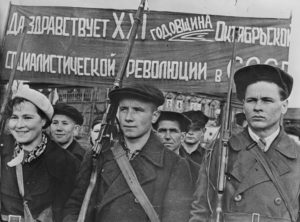
Prof.dr. Robert Pollin
This is part two of a wide-ranging interview with world-renowned public intellectuals Noam Chomsky and Robert Pollin. Read part one here. The next installment will appear on October 31.
C.J. Polychroniou: Noam, racism, inequality, mass incarceration and gun violence are pathologies that run deep inside American society. How would a progressive government begin to address these problems if it found itself in a position of power in, say, the next decade or so?
Noam Chomsky: Very serious problems, no doubt. In order to address them effectively, it’s first necessary to understand them; not a simple matter. Let’s take the four pathologies in turn.Racism certainly runs deep. There is no need to elaborate. It’s right before our eyes in innumerable ways, some with considerable historical resonance. Current anti-immigrant hysteria can hardly fail to recall the racist immigration laws that at first barred [Asians] and were extended in the 1920s to Italians and Jews (under a different guise) — incidentally, helping to send many Jews to gas chambers, and after the war, keeping miserable survivors of the Holocaust from US shores.

Noam Chomsky ~ Photo: en.wikipedia.org
Of course, the most extreme case for the past 400 years is the bitter history of African Americans. Current circumstances are shameful enough, commonly held doctrines scarcely less so. The hatred of Obama and anything he touched surely reflects deep-rooted racism. Comparative studies by George Frederickson show that doctrines of white supremacy in the US have been even more rampant than in Apartheid South Africa.
The Nazis, when seeking precedents for the Nuremberg laws, turned to the United States, taking its anti-miscegenation laws as a model, though not entirely: [Certain] US laws were too harsh for the Nazis because of the “one drop of blood” doctrine. It was not until 1967, under the impact of the civil rights movement, that these abominations were struck down by the Supreme Court.
And it goes far back, taking many strange forms, including the weird Anglo-Saxon cult that has been prominent for centuries. Benjamin Franklin, the great American figure of the Enlightenment, pondered whether Germans and Swedes should be barred from the country because they are “too swarthy.” Adopting familiar understanding, he observed that “the Saxons only [are] excepted” from this racial “defect” — and by some mysterious process, those who make it to the United States may become Anglo-Saxons, like those already accepted within the canon.
The national poet Walt Whitman, honored for his democratic spirit, justified the conquest of half of Mexico by asking, “What has miserable, inefficient Mexico … to do with the great mission of peopling the New World with a noble race? Be it ours, to achieve that mission!” — a mission accomplished by the most “wicked war” in history, in the judgment of General-President U.S. Grant, who later regretted his service in it as a junior officer.
Coming to recent years, Henry Stimson, one of the most distinguished members of the FDR-Truman cabinets (and one of the few to oppose atomic bombing) “consistently maintained that Anglo-Saxons were superior to the ‘lesser breeds’,” historian Sean Langdon Malloy observes in his book, Atomic Tragedy: Henry L. Stimson and the Decision to Use the Bomb — and again reflecting not-uncommon views, asked to have one of his aides reassigned “on the slight possibility that he might be a Hebrew,” in his own words.
The other three maladies that you mention are also striking features of US society — in some ways, even distinguishing features. But unlike racism, in all three cases, it is partially a contemporary phenomenon.
Take inequality. Through much of its history, the US did not have high inequality as compared with Europe. Less so, in fact. That began to change in the industrial age, reaching a peak in 1928, after the forceful destruction of the labor movement and crushing of independent thought. Largely as a result of labor mobilization, inequality declined during the Great Depression, a tendency continuing through the great growth period of regulated capitalism in the early postwar decades. The neoliberal era that followed reversed these trends, leading to extreme inequality that may even surpass the 1928 peak.
Mass incarceration is also period-specific; in fact, the same period. It had reached high levels in the South in the post-reconstruction years after an 1877 North-South compact gave the South free rein to institute “slavery by another name,” as Douglas Blackmon calls the crime in his study of how the former slave-owning states devised techniques to incarcerate much of the Black population. By doing so, they created a renewed slave labor force for the industrial revolution of those years, this time with the state, rather than private capital, responsible for maintaining the slave labor force — a considerable benefit to the ownership class. Turning to more recent times, 30 years ago, US incarceration rates were within the range of developed societies, a little towards the high end. By now they are 5 to 10 times as high, far beyond those of any country with credible statistics. Again, a phenomenon of the past three decades.
The gun cult is also not as deeply rooted as often supposed. Guns were, of course, needed to conduct the two greatest crimes of American history: controlling slaves and exterminating [Native Americans]. But the general public had little interest in weapons, a matter of much concern to the arms industry. The popular gun cult was cultivated by gun manufacturers in the 19th century in order to create a market beyond governments. Normal capitalism. Methods included concoction of “Wild West” mythology that later became iconic. Such efforts continue, vigorously, until the present. By now, in large sectors of the society, swaggering into a coffee shop with a gun shows that you are really somebody, maybe a Wyatt Earp clone. The outcomes are sobering. Gun homicides in the US are far beyond comparable countries. In Germany, for example, deaths from gun homicide are at the level of deaths in the US from “contact with a thrown or falling object.” And even these shocking figures are misleading. Half of suicides in the US are with firearms, more than 20,000 a year, amounting to two-thirds of all firearm deaths.
Turning to your question about the four “pathologies” — the four horsemen, one is tempted to say — the questions virtually answer themselves with a careful look at the history, particularly the history since World War II. There have been two phases during the postwar period: regulated capitalism through the ’50s and ’60s, followed by the neoliberal period from the late ’70s, sharply accelerating with Reagan and his successors. It is the latter period when the last three of four pathologies drove the US off the charts.
During the first postwar phase, there were some significant steps to counter endemic racism and its devastating impact on the victims. That was the great achievement of the mass civil rights movement, peaking in the mid-1960s, though with a very mixed record since. The achievements also had a major impact on the political system. The Democratic Party had been an uneasy coalition, including Southern Democrats, dedicated to racist policies and extremely influential because of seniority in one-party states. That’s why New Deal measures [were] largely restricted to whites; for example, household and agricultural workers were barred from Social Security.
The alliance fell apart in the ’60s with the fierce backlash against extending minimal rights of citizenship to African-Americans. The South shifted to Republican ranks, encouraged by Nixon’s overtly racist “Southern strategy.” The period since has hardly been encouraging for African Americans, apart from elite sectors.
Government policies could go some way towards ameliorating these social pathologies, but a great deal more is needed. Such needs can only be fulfilled by dedicated mass popular activism and educational/organizational efforts. These can be facilitated by a more progressive government, but, just as in the case of the civil rights movement, that can be only a help, often a reluctant one.
On inequality, it was low (by comparative standards) during the period of regulated capitalism — the final era of “great compression” of income as it is sometimes called. Inequality began to increase rapidly with the advent of the neoliberal era, not only in the US, though the US is extreme among developed societies. During the tepid recovery from the Great Recession of 2008, virtually all gains went to the top few percent, mostly 1 percent or a fraction thereof. “For the United States overall, the top 1 percent captured 85.1 percent of total income growth between 2009 and 2013,” an Economic Policy Institute Study revealed. “In 2013 the top 1 percent of families nationally made 25.3 times as much as the bottom 99 percent.” And so, it continues. The latest Federal Reserve studies show that “The share of income received by the top 1 percent of families rose to 23.8 percent in 2016, up from 20.3 percent in 2013. The share of the bottom 90 percent of the distribution fell to 49.7 percent, the lowest on record in the survey’s history.” Other figures are grotesque. Thus, “Average wealth holdings for white families in 2016 were about $933,700, compared with $191,200 for Hispanic families and $138,200 for black families,” a product of deep-rooted racism exacerbating the neoliberal assault.
The gun culture, too, has expanded rapidly in recent decades. In 1975, the NRA formed a new lobbying arm — a few years later, a PAC — to channel funds to legislators. It soon became one of the most powerful interest-group lobbies, with often fervent popular participation. In 2008, the Supreme Court, in an intellectual triumph of “originalism,” reversed the traditional interpretation of the Second Amendment, which had previously respected its explicit condition on the right to bear arms: the need for “A well regulated Militia, being necessary to the security of a free State….” That provision was understandable in 1790. There was almost no standing army. The world’s most powerful state was still an enemy. The slave population had to be controlled. And the invasion of the rest of what became the national territory was about to be unleashed. Not exactly today’s circumstances.
Since 2008, our “constitutional right to bear arms,” as declared by the right-wing Roberts Court, has become Holy Writ.
There are many contributing factors to the sharp break between the two postwar periods — neither [of] which began to approach what is surely possible in the richest society in world history, with incomparable advantages.
One leading factor is the financialization of the economy, creating a huge bloc of largely predatory institutions devoted to financial manipulations rather than to the real economy — a process by which “Wall Street destroyed Main Street,” in the words of Financial Times editor Rana Foroohar. One of her many illustrations is the world’s leading corporation, Apple. It has astronomical wealth, but to become even richer, has been shifting from devising more advanced marketable goods to finance. Its R&D as a percentage of sales has been falling since 2001, tendencies that extend widely among major corporations. In parallel, capital from financial institutions that financed business investments during the postwar growth period now largely “stays inside the financial system,” Foroohar reports, “enriching financiers, corporate titans, and the wealthiest fraction of the population, which hold the vast majority of financial assets.”
During the period of rapid growth of financial institutions since the ’70s, there seem to have been few studies of their impact on the economy. Apparently, it was simply taken for granted that since it (sort of) accords with neoliberal market principles, it must be a Good Thing.
The failure of the profession to study these matters was noted by Nobel laureate in economics Robert Solow after the 2008 crash. His tentative judgment was that the general impact is probably negative: “the successes probably add little or nothing to the efficiency of the real economy, while the disasters transfer wealth from taxpayers to financiers.” By now, there is substantially more evidence. A 2015 paper by two prominent economists found that productivity declines in markets with rapidly expanding financial sectors, impacting mostly the sector most critical for long-term growth and better jobs: advanced manufacturing. One reason, Foroohar observes, is that “finance would rather invest in areas like real estate and construction, which are far less productive but offer quicker, more reliable short-term gains” (hence also bigger bonuses for top management); the Trump-style economy, palatial hotels and golf courses (along with massive debt and repeated bankruptcies).
In part for related reasons, though productivity has doubled since the late ’70s when finance was beginning to take over the economy, wages have stalled — for male workers, declined. In 2007, before the crash, at the height of euphoria about the grand triumphs of neoliberalism, neoclassical economics and “the Great Moderation,” real wages of American workers were lower than they had been in 1979, when the neoliberal experiment was just taking off. Another factor contributing to this outcome was explained to Congress in 1997 by Fed Chair Alan Greenspan, when testifying on the healthy economy he was managing. In his own words, “Atypical restraint on compensation increases has been evident for a few years now and appears to be mainly the consequence of greater worker insecurity.” Insecurity that was, as he noted, markedly increasing even as employment prospects improved. In short, with labor repressed and unions dismantled, workers were too intimidated to seek decent wages and benefits, a sure sign of the health of the economy.
The same happened to the minimum wage, which sets a floor for others; if it had continued to track productivity, it would now be close to $20 an hour. Crises have rapidly increased as deregulation took off, in accord with the “religion” that markets know best, deplored by another Nobel laureate, Joseph Stiglitz, in a World Bank publication 20 years ago, to no effect. Each crisis is worse than the last; each following recovery weaker than the last. None of this, incidentally, would have come as a surprise to Marxist economists, who pretty much disappeared from the scene in the United States.
Despite much lofty rhetoric about “free markets,” like other major industries (energy, agribusiness, etc.), financial institutions benefit enormously from government subsidy and other interventions. An IMF study found that the profits of the major banks derive substantially from the implicit government insurance policy (“too big to fail”), which confers advantages far beyond the periodic bailouts when corrupt practices lead to a crash — something that did not happen during the earlier period, before bipartisan neoliberal doctrine fostered deregulation. Other benefits are real but immeasurable, like the incentive to undertake risky (hence profitable) transactions, with the understanding that if they crash, the hardy taxpayer will step in to repair the damage, probably leaving the institutions richer than before, as after the 2008 crash for which they were largely responsible.
Other factors include the accelerated attack on unions and the radical reduction in taxes for the wealthy, both natural concomitants of neoliberal ideology. Another is the particular form of neoliberal globalization, particularly since the ’90s, designed in ways that offer very high protection and other advantages to corporations, investors and privileged professionals, while setting working people in competition with one another worldwide, with obvious consequences.
Such measures have a mutually reinforcing effect. As wealth becomes more concentrated, so, automatically, does political power, which leads to government policies that carry the cycle forward.
A primary goal of the neoliberal reaction was to reverse the falling rate of profit that resulted, in part, from growing labor militancy. That goal has been achieved with impressive success. The professed goals, of course, were quite different. And as always, the reaction was buttressed by ideology. One staple has been the famous thesis of Simon Kuznets: that while inequality increases in early economic development, it begins to decrease as the economy reaches a more advanced level. It follows, then, that there is no need for redistributive policies that interfere with the magic of the market. The Kuznets thesis soon became conventional wisdom among economists and planners.
There are a few problems, however. One, as [American University economics professor] Jon Wisman observes, is that it wasn’t a thesis, but rather a conjecture, very cautiously advanced. As Kuznets explained, the conjecture was based on “perhaps 5 percent empirical information and 95 percent speculation, some of it possibly tainted by wishful thinking.” This slight qualification in the article was overlooked in a manner not uncommon when there is doctrinal utility in so doing. Other justifications fare similarly.
One might almost define “neoliberalism” — a bit cruelly, but not entirely unfairly — as an ideology devoted to establishing more firmly a society based on the principle of “private affluence, public squalor” — John Kenneth Galbraith’s condemnation of what he observed in 1958. Much worse was to come with the unleashing of natural tendencies of capitalism in the neoliberal years, now enhanced as its more [brutal] variants are given virtually free rein under Trump-Ryan-McConnell Republicanism.
All of this is under human control, and can be reversed. There are many realistic options, even without looking beyond short-term feasibility. A small financial transaction tax would sharply reduce the rapid trading that is a net loss to the society while benefiting a privileged few, and would also provide a progressive government with revenue for constructive purposes. It’s common knowledge that the deterioration of infrastructure has reached grotesque proportions. Government programs can begin to address these serious problems. They can also be devoted to improving rather than undermining the deteriorating public education system. Living wage and green economy programs of the kind that Bob Pollin has developed could go a long way toward reducing inequality, and beyond that, creating a much more decent society. Another major contribution would be [an equitable] health care system. In fact, just eliminating the exorbitant patent protections that are a core part of the neoliberal “free trade agreements” would be a huge boon to the general economy — and the arguments for these highly protectionist measures are very weak, as economist Dean Baker has shown convincingly. Legislation to put an end to the “right to scrounge laws” (in Orwellian terminology, “right to work laws”) that are designed to destroy unions could help revive the labor movement, by now with different constituencies, including service and part-time workers. That could reverse the growth of the new “precariat,” another matter of fundamental importance. And it could restore the labor movement to its historic role as the leading force in the struggle for basic human rights.
There are other paths toward reviving a vital and progressive labor movement. The expansion of worker-owned and managed enterprises, now underway in many places, is a promising development, and need not be limited to a small scale. A few years ago, after the crash, Obama virtually nationalized a large part of the auto industry, then returning it to private ownership. Another possibility would have been to turn the industry over to the workforce, or to stakeholders more broadly (workers and community), who might, furthermore, have chosen to redirect its production to what the country sorely needs: efficient public transportation. That could have happened had there been mass popular support and a receptive government. Recent work by Gar Alperovitz and David Ellerman approaches these matters in highly informative ways. Conversion of military industry along similar lines is also quite conceivable — matters discussed years ago by Seymour Melman. [There are all] options under progressive initiatives.
The “right to work” legislation that is a darling of the far right will probably soon be established solidly by the Roberts Court now that Neil Gorsuch is in place, thanks to some of Mitch McConnell’s more sordid chicanery in barring Obama’s nominee. The legislation has an interesting pedigree. It traces back to the Southern Christian American Association, an extreme racist and anti-Semitic organization that was bitterly opposed to unions, which its leaders condemned as a devilish contrivance in which “white women and white men will be forced into organizations with black African apes.” Another enemy was “Jewish Marxism,” the “Talmudists” who were planning to Sovietize the world and were already doing so in the US through the “Jew Deal,” known elsewhere as the “New Deal.”
An immediate objective of moderately progressive policy should be to sharply cut the huge military budget, well over half of discretionary spending and now expanding under the Republican project of dismantling government, apart from service to their wealthy/corporate constituency. One of many good reasons to trim the military budget is that it is extremely dangerous to our own security. A striking illustration is the Obama-Trump nuclear weapons modernization program, which has sharply increased “killing power,” a very important study in the Bulletin of Atomic Scientists reported last March. Thereby, the program “creates exactly what one would expect to see, if a nuclear-armed state were planning to have the capacity to fight and win a nuclear war by disarming enemies with a surprise first strike.” These developments, surely known to Russian planners, significantly increase the likelihood that they might resort to a preemptive strike — which means the end — in case of false alarms or very tense moments, of which there are all too many. And here, too, the funds released could be devoted to badly needed objectives, like quickly weaning ourselves from the curse of fossil fuels.
This is a bare sample. There’s a long list.
The United States spends more money on health care than any other nation in the world, yet its health care system is highly inefficient and leaves out millions from even basic coverage. What would a socialized health care system look like in the US, and how can the opposition from the private insurance sector, big pharma and the medical industries in general be overcome?
Noam Chomsky: The facts are startling. It’s an international scandal, and not unknown. A recent study by the US-based Commonwealth Fund, a nonpartisan health policy research group, found that once again, as repeatedly in the past, the US health care system is the most expensive in the world, far higher than comparable countries, and that it ranks last in performance among these countries. To have combined these two results is a real triumph of the market. The roots of the achievement are not obscure. The US is alone in relying on largely unregulated private insurance companies. Their commitment is to profit, not health, and they produce huge waste in administrative costs, advertising, profit and executive compensation. The government-run component of the health system (Medicare) is far more efficient, but suffers from the need to work through the private institutions. The US is also alone in legislation barring the government from negotiating drug prices, which, not surprisingly, are far above comparable countries.
These policies do not reflect popular will. Poll results vary, depending on how questions are formulated, but over time, they show considerable, often majority support for a public health system of the kind found elsewhere. Usually, Canada is the model because so little is known about the rest of the world, though it is not ranked as the best. That prize has regularly been won by the British National Health Service, though it, too, is reeling under the neoliberal assault. When Obama’s [Affordable Care Act] was introduced, it included a public option, supported by almost two-thirds of the population. It was unceremoniously deleted. Popular opinion is particularly striking in that [it] receives so little mainstream support, even articulation; and if even brought up, is usually condemned. The main argument against the far more successful systems elsewhere is that adopting their framework would raise taxes. [However, single-payer usually results in] cutting expenses considerably more and benefitting the large majority — so the experience of other countries indicates, [as does] US Medicare.
The tide may be turning finally. Sanders has received considerable support, even within the political system, for his call for universal health care to be achieved step-by-step in his plan, by gradual extension of Medicare and other means. The temporary collapse of the fanatic seven-year Republican campaign to destroy “Obamacare” may provide openings as well — temporary collapse, because the extremist organization in power has means to undermine health care and are likely to use it in their passionate dedication to destroying anything connected to the reviled Black president…. Nevertheless, there are new openings for some degree of [reason], which could greatly enhance people’s welfare, as well as improving the general economy.
To be sure, there will be massive opposition from private power, which has extraordinary influence in our limited class-based democracy. But it can be overcome. The historical record shows that economic-political elites respond to militant popular action — and the threat of more — by endorsing ameliorative measures that leave their basic dominance of the society in place. New Deal measures of social reform are one of many illustrations.
Bob, you produced recently an economic analysis for the backing of a single-payer bill in California (SB-562) and worked on Bernie Sanders’s proposal for universal health care, so what are your own views on the previous question?
Robert Pollin: A socialized health care system for the US — whether we call it “single-payer,” “Medicare-for-All” or something else — should include two basic features. The first is that every resident … should be guaranteed access to decent health care. The second is that the system achieves significant overall savings relative to our existing system through lowering administrative costs, controlling the prices of prescription drugs and fees for physicians and hospitals, reducing unnecessary treatments and expanding preventive care.
In our study analyzing the California single-payer proposal, we estimated that providing decent coverage for all state residents — including, in particular, the roughly 40-45 percent of the state’s population who are presently either uninsured or who have inadequate coverage — would increase total costs by about 10 percent under the existing system. But we also estimated that operating the single-payer system could achieve overall savings in the range of 18 percent relative to the existing system in the areas of administration, drug prices, fees for providers and cutting back on wasteful service delivery. Overall then, we found that total health care spending in California would fall by about 8 percent, even with the single-payer system delivering decent care for everyone. My work on the Sanders’s Medicare for All bill is ongoing as of now, so I will hold off on providing estimates of its overall impact.
Let’s consider how transformative the California-type outcomes would be. Under single-payer in California, decent health care would be established as a basic human right, as it already is in almost all other advanced countries. Nobody would have to forego receiving needed treatments because they didn’t have insurance or they couldn’t afford high insurance premiums and copays. Nobody would have to fear a financial disaster because they faced a health care crisis in their family. Virtually all families would end up financially better off and most businesses would also experience cost savings under single-payer relative to what they pay now to cover their employees.
How can the opposition from the private health insurance sector, big pharma and the medical industries in general be overcome? It obviously will not be easy. Health care in the US is a $3 trillion business. Profits of the private companies are in the hundreds of billions, even while most of the funding for our existing health care system comes from the federal, state and local government budgets. As one example of how to respond to this political reality, we can learn from the work of the California Nurses Association/National Nurses United. The nurses’ union has been fighting for single-payer for over 20 years. They bring enormous credibility to the issue, because their members see firsthand how the health and financial well-being of especially non-wealthy people in the US suffer under our current system.
There is no secret as to how the nurses’ union fights on behalf of single-payer. They believe in their cause and are highly effective in the ways they organize and advance their position. The basics are as simple as that.
Copyright, Truthout. May not be reprinted without
permission.





